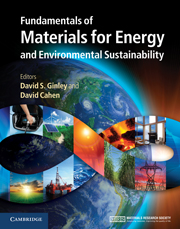Book contents
- Frontmatter
- Contents
- Contributors
- Preface
- Acknowledgments
- Part 1 Energy and the environment: the global landscape
- Part 2 Nonrenewable energy sources
- Part 3 Renewable energy sources
- 17 Solar energy overview
- 18 Direct solar energy conversion with photovoltaic devices
- 19 Future concepts for photovoltaic energy conversion
- 20 Concentrating and multijunction photovoltaics
- 21 Concentrating solar thermal power
- 22 Solar thermoelectrics: direct solar thermal energy conversion
- 23 Off-grid solar in the developing world
- 24 Principles of photosynthesis
- 25 Biofuels and biomaterials from microbes
- 26 Biofuels from cellulosic biomass via aqueous processing
- 27 Artificial photosynthesis for solar energy conversion
- 28 Engineering natural photosynthesis
- 29 Geothermal and ocean energy
- 30 Wind energy
- Part 4 Transportation
- Part 5 Energy efficiency
- Part 6 Energy storage, high-penetration renewables, and grid stabilization
- Summary
- Appendix A Thermodynamics
- Appendix B Electrochemistry
- Appendix C Units
- Index
- References
21 - Concentrating solar thermal power
from Part 3 - Renewable energy sources
Published online by Cambridge University Press: 05 June 2012
- Frontmatter
- Contents
- Contributors
- Preface
- Acknowledgments
- Part 1 Energy and the environment: the global landscape
- Part 2 Nonrenewable energy sources
- Part 3 Renewable energy sources
- 17 Solar energy overview
- 18 Direct solar energy conversion with photovoltaic devices
- 19 Future concepts for photovoltaic energy conversion
- 20 Concentrating and multijunction photovoltaics
- 21 Concentrating solar thermal power
- 22 Solar thermoelectrics: direct solar thermal energy conversion
- 23 Off-grid solar in the developing world
- 24 Principles of photosynthesis
- 25 Biofuels and biomaterials from microbes
- 26 Biofuels from cellulosic biomass via aqueous processing
- 27 Artificial photosynthesis for solar energy conversion
- 28 Engineering natural photosynthesis
- 29 Geothermal and ocean energy
- 30 Wind energy
- Part 4 Transportation
- Part 5 Energy efficiency
- Part 6 Energy storage, high-penetration renewables, and grid stabilization
- Summary
- Appendix A Thermodynamics
- Appendix B Electrochemistry
- Appendix C Units
- Index
- References
Summary
Focus
Power generation from solar energy by thermomechanical conversion is a major path for creating clean renewable power, while building on the mature technology base of conventional power plants. This solar technology was the first for which it was possible to demonstrate full-scale power plants (using Luz parabolic troughs built in California during the 1980s). With plants generating several thousands of megawatts currently in operation and under construction around the world, concentrating solar thermal power is fast becoming a mainstream solar power technology.
Synopsis
Solar thermal power generation includes three conversion steps: from solar radiation to heat, from heat to mechanical work, and from work to electricity. The last two steps are well known from conventional power plants, with the leading technologies being heat engines based on the steam cycle and the gas turbine cycle. A solar thermal plant can use these mature heat-engine technologies with the replacement of fuel-fired heat by “solar-fired” heat. Providing heat from solar energy at the appropriate temperatures requires concentration of the sunlight, because, otherwise, heat losses to the environment are too high. The leading concentration methods are linear concentrators (parabolic trough and linear Fresnel), towers with heliostat fields, and parabolic dishes, each of which is suitable for a range of operating temperatures and types of heat engine. Considering the inherent energy losses in the process of concentration, the overall solar plant efficiency (from collected solar radiation to electricity) is typically in the range 15%–25%, with the best systems reaching around 30%.
- Type
- Chapter
- Information
- Publisher: Cambridge University PressPrint publication year: 2011

